I would be amiss if I didn’t express to you how dang excited I am to share with you one of my favorite types of vegetarian charcuterie boards…a Mezze platter, which is essentially a Mediterranean cheese and snack board.
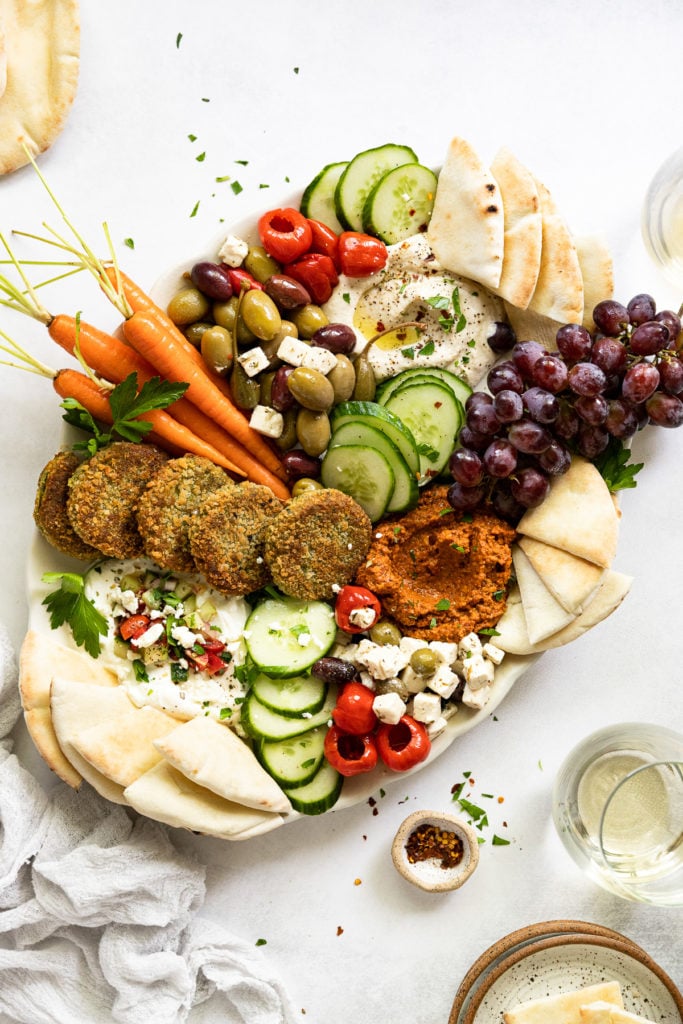
Around here, we are huge fans of Mediterranean-inspired dishes…combining bright, tangy flavors on flatbread pizzas, pasta salads, and one of our all-time favorites, Mediterranean nachos!
And if it wasn’t abundantly obvious, we’re also huge fans of themed grazing boards….grazing platters…snack plates…whatever you want to call them, snacking on bits of this-and-that is our JAM.
In fact, it’s one of the best ways to eat because you get a little bit of everything, while simultaneously being able to eat, well, all night long…that’s what I call winning! So let’s dive into making this easy vegetarian mezze platter so you, too, can get to snacking ASAP!
What is a Mezze Platter?
The word meze or mezze originated from the Turkish word meaning snack or appetizer, which is absolutely fitting. A mezze platter consists of small dishes that are served for exactly that purpose: as an appetizer or light meal.
Mezze (or meze) is pronounced meh-ZEH.
Mezze platters are popular snack boards throughout the Middle East and the Mediterranean, and depending on the region, the dishes on a specific mezze platter will vary. For example, in Turkey, you’ll often find seafood salads and hot pepper paste. In Greece and surrounding areas, you’ll find olives, vegetables, and grilled cheeses.
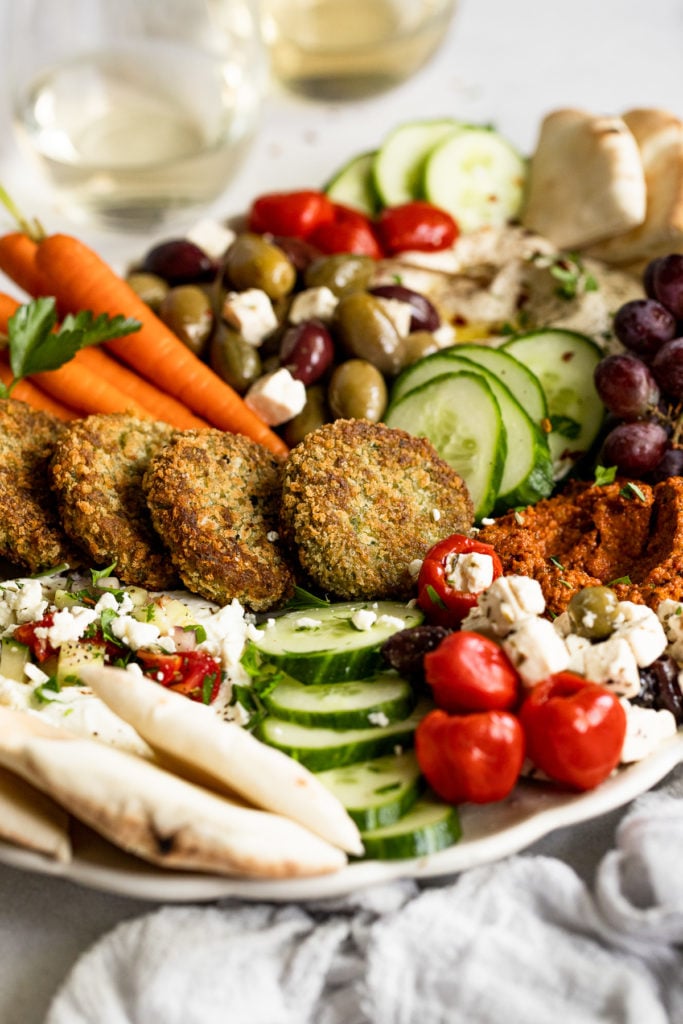
You’ll also find a variety of salads like baba ganoush, other eggplant salads, tabbouleh, and dolma depending on the region. On non-vegetarian platters, kebabs, grilled seafood, cold cuts, or other meat dishes can be included as well.
Check out this comprehensive list for more details about mezze platter dishes by region.
What to Put on a Vegetarian Mediterranean Board
There are honestly so many snacks, dips, and finger foods you can place on the board, and there is no wrong way to mix or match them. Here are a variety of sharing platter ideas, broken down into these categories for easy browsing.
The outline I follow when creating a Mediterranean mezze board goes like this…but again, this is just an outline and you can feel free to use what you have and love!
- 3 Dips or Spreads (you can always use more, too!)
- 1-2 Cheeses
- Fresh Veggies both for dipping and snacking alone…and to add color!
- Dried or Fresh Fruit
- 2-3 Briney, Savory Items
- 2-3 Finger Foods
- Carb dipping vehicle (pita!)
Dips and Spreads
Oh, you know I love a delicious dip recipe, and while more traditional charcuterie boards don’t always have the dip aspect, I am happy to say that they are one of the main components of mezze boards! YES! I like to include at least 3 dips and spreads for variety.
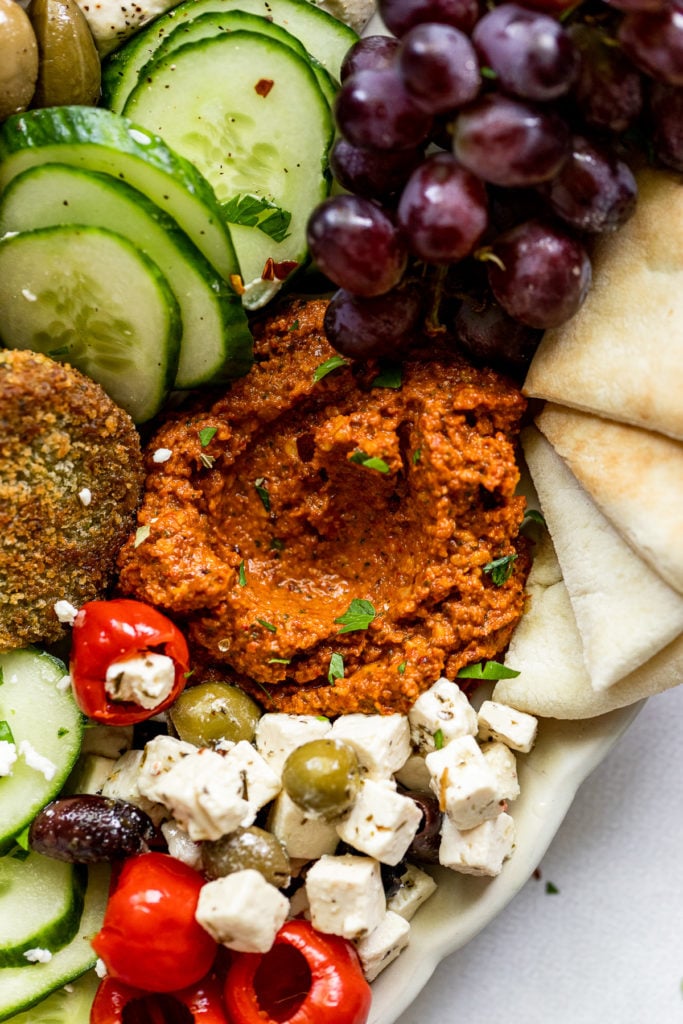
You can buy store-bought dips or make your own, then place them either directly on your platter or board, or in their own bowls.
- Hummus – a must in my book. Try this roasted garlic hummus or sun-dried tomato hummus.
- Olive Tapenades – excellent for olive lovers! Try green olive or black olive tapenade.
- Artichoke Tapenade – a more mild tapenade than the olives
- Tzatziki Sauce – creamy and easy to make, a very popular meze in Greece
- Labneh – strained yogurt sauce
- Toum – garlic dipping sauce
- Lemon Herb Tahini Dip
- Whipped Feta – top it with the greek bruschetta mixture – as pictured
- Romesco Sauce – pictured
Cheeses
Ah, how I love cheeses on any kind of grazing board…and there are some super fun varieties you can add to a mezze board!
- Marinated Feta – buy a block and marinate it in olive oil, red pepper flakes, and herbs. Or simply buy it pre-marinated at the deli of your local grocery store.
- Mozzarella Pearls – these small mozzarella balls are perfect for snacking. You can marinate them, too, or enjoy them as they are.
- Grilled Halloumi – it’s super melty when warm and grilled; turns a little squeaky when cooled.
- Saganaki
Note: these cheeses should already be vegetarian just because of how they’re made, but be sure to check for cheese labeled vegetarian (or made with microbial enzymes), if needed.
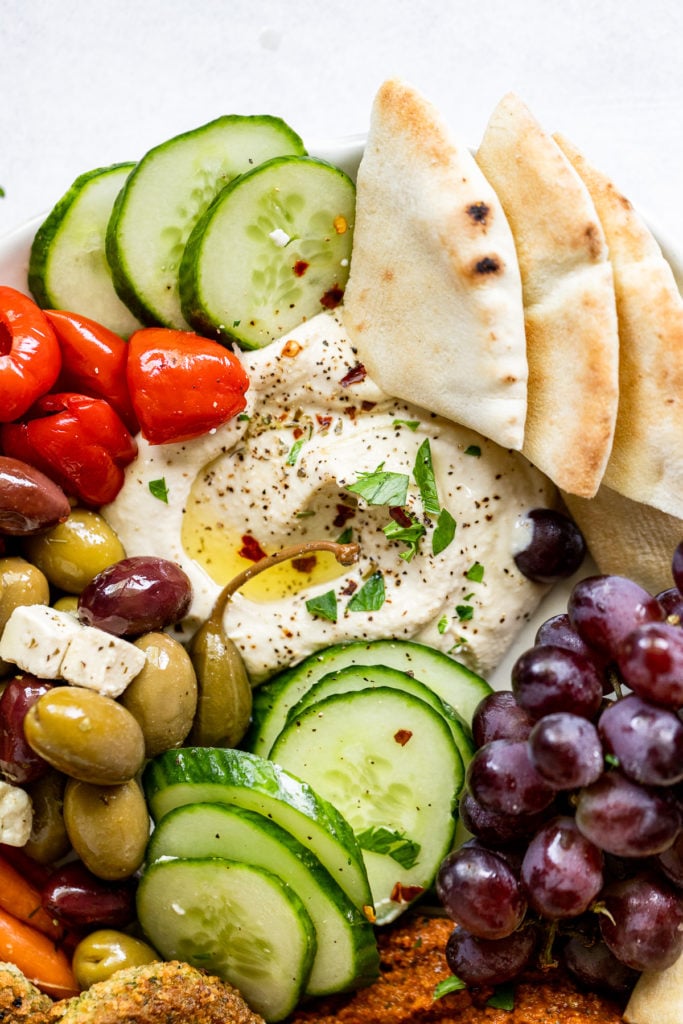
Fresh Veggies
Perfect for enjoying on their own or dipping! I recommend making them large enough to grab off of the board and a size that’s good for dipping.
- Carrots – whole or cut into sticks
- Cucumbers – sliced on the bias for more surface area, or cut into sticks
- Tomatoes – whole cherry or cocktail tomatoes are great
- Radishes – quartered or halved
- Artichokes – fresh and grilled, if in season, or marinated
- Bell Peppers – sliced
Fruit: Dried or Fresh
Adding fruit is an excellent way to balance out the bold, bright, tangy flavors that generally accompany a Mediterranean board.
- Figs – dried or fresh, cut in half
- Grapes – red or green, or use raisins
- Apricots – fresh or dried
- Pomegranate – definitely fresh!
Briny and Savory Bites
It wouldn’t be a mezze board without olives! Here are a few more savory and briny components to consider adding:
- Olives – kalamata or green olives are excellent, serve marinated olives or a variety you find in the deli section of your local grocery store
- Pickles
- Peppadew Peppers – sweet and spicy, stuff them with goat cheese, too
- Roasted Red Bell Peppers
- Marinated Artichokes
- Mixed Nuts – throwing these along with the savory (a stretch, I know!) but they’re a simple addition to fill in any gaps and make for a good palate cleanser
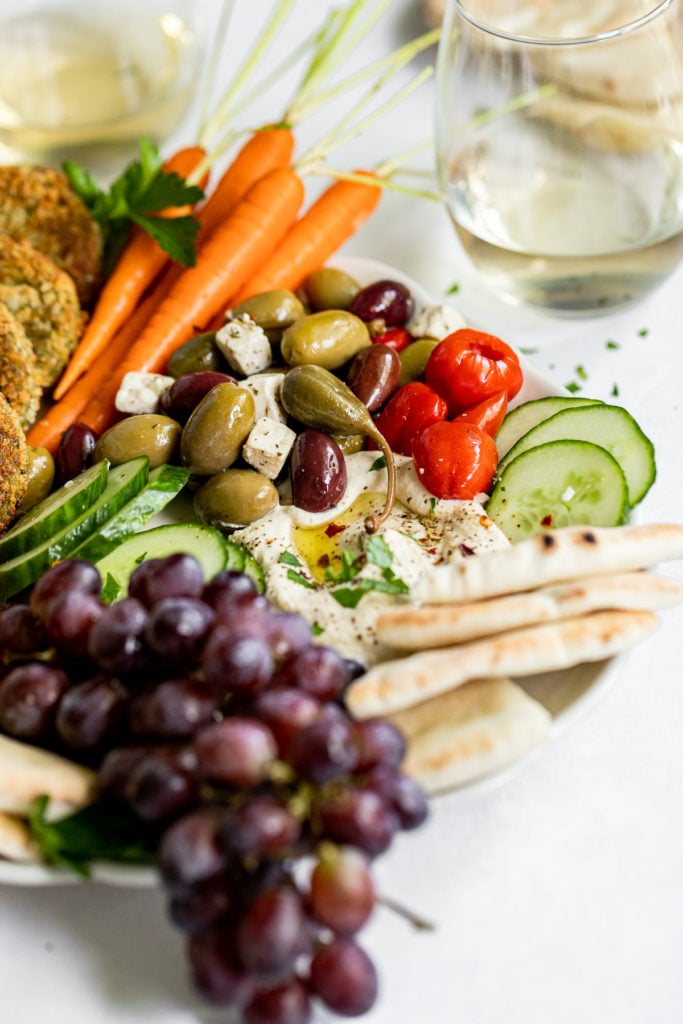
Hearty Finger Foods & Salads
These additions are perfect for a board because they are hearty enough to hold you over if serving the board for a meal, and they add variety and substance, especially to a vegetarian board that’s made without meat.
- Falafel – a must on my mezze platter…might as well just call it a falafel board!
- Domas – stuffed grape leaves
- Tabbouleh – a bright salad made with parsley, tomatoes, mint, onion, and bulgur
- Baba Ganoush – one version of eggplant salad you’ll find on mezze platters
- Greek Bruschetta – serve the topping as is with the crostini on the side
- Hard-Boiled Eggs – a common addition
Carbs, carbs, and more carbs!
You know I’m not making a snack board without carbs. Perfect for enjoying as a dipping vehicle or on their own (or maybe even creating your own mini falafel sandwich?!).
- Pita – an excellent option, cut it into triangles and place it around the board
- Socca – this chickpea flatbread is a fun gluten-free alternative, it’s slightly crispy, too!
- Grilled Bread or Crostini
- Homemade Flatbread
- Crackers
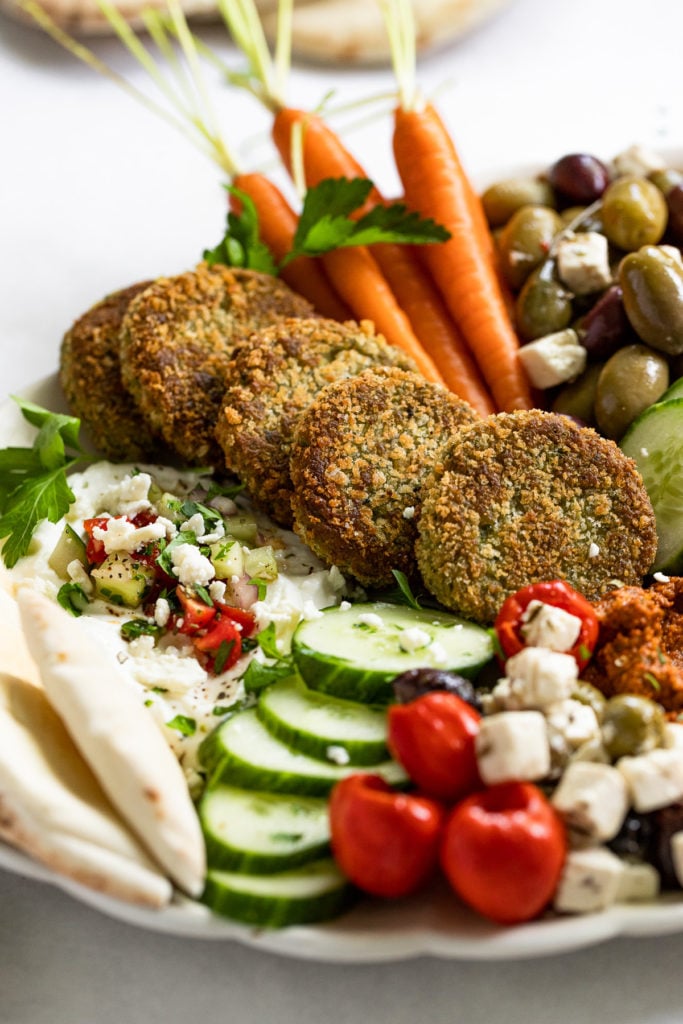
Tips for Assembling a Mezze Platter
When you create any type of grazing board, it’s important to remember the first key rule: there are no rules. Yes, there are guidelines for making the board as visually appealing as possible, but truly, there are no rules, and you can add whatever you want to nosh on.
The whole point of a mezze platter is that it is intended for sharing. So make it plentiful. Grab your largest board or serving tray and fill it up!
…but don’t put everything on it at once. You want to fill up the board but you don’t want to overcrowd it. Make sure your guests can still see and grab what they want without creating a mess. As items are enjoyed, continue replacing them on the board.
Place any items in bowls on the board first, or if you are spreading the dips on the board, do so first.
As I mention every time I make a vegetarian board, it’s important to put the largest items on first and then fill in the spaces, working down in size. This means that in the end, you’re filling in the small areas that are left with smaller items, like olives, nuts, or berries.
And a few more things to keep in mind:
- Check your cupboard and fridge first! You might be amazed to find bags of dried fruit or jarred olives you have lying around that will be perfect to add to the board. This will also save you money (yes!!).
- Don’t be afraid to place items off of the board. This might be slices of pita you have in a bowl alongside the board or additional dips or bruschetta that just does better on its own plate.
- Set out toothpicks or small forks so your guests have easy access to items instead of grabbing them with their hands.
- Place the same item in different places around the board. That’s right, the olives don’t have to be in the “olive only” section. Place a few here and a few there; it makes it visually interesting and means guests can reach items from all around the board.
- Add those garnishes! Make a swoop in your hummus and drizzle on some high-quality olive oil and top with roasted chickpeas or pine nuts.
- Add fresh parsley leaves and mint throughout for a beautiful pop of color and freshness.
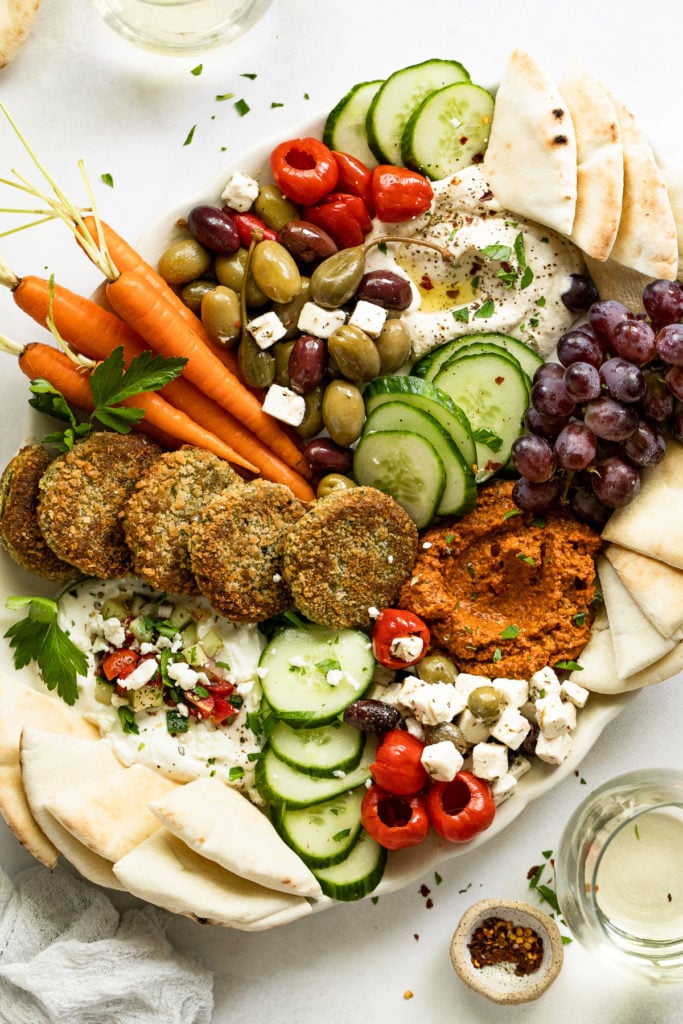
What kind of board or platter should I use?
Often, when making cheese boards, I use a large, round food-safe wooden board, which is an excellent option for a mezze platter, too.
For this board, however, I used this large serving platter, for a few reasons. One, it’s gorgeous. And because it’s a mezze platter, this serving tray just felt a little more elevated, so I wanted to use a nicer tray.
I also knew I wanted to spread the dips directly on the board, so by using the serving tray I knew it would be completely food-safe to do so.
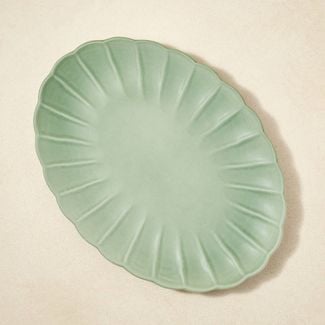
15×11 Scalloped Serving Platter
This is the serving platter used in the photos for this Mediterranean board. Mine is the cream-colored board.
Photo credit: www.target.com
As I said earlier, there are no rules, so go ahead and use whichever type of serving tray, board, or cutting board you have (yes, cutting boards work in a pinch – just make sure it’s not your meat-only cutting board!).
The size truly just depends on how many guests you’ll be serving. For a crowd, you might want to consider a large wooden board, because the bigger, the better in that case. For a smaller group of about 4-6, an everyday serving tray should be fine for size.
Did you make this recipe? Please leave a star rating and review in the form below. I appreciate your feedback, and it helps others, too!
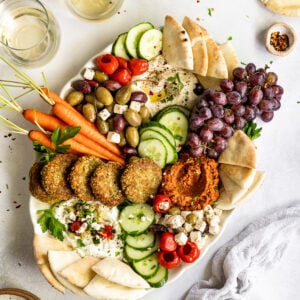
Get the Recipe Vegetarian Mezze Platter (Mediterranean Board)
Ingredients
*Ingredients with amounts are in featured in the photos, others are additional recs. See notes below.
Spreads & Dips (3-4)
- 1 cup whipped feta
- 1 cup hummus
- 1 cup romesco sauce
- tzatziki sauce
- olive tapenade
- toum garlic dip
Cheese (1-2)
- 8 ounces feta cubes, marinated
- 8 ounces mozzarella pearls
Savory Components
- 1 cup kalamata olives, or your favorite olive blend
- 1 cup peppadew peppers
- mixed nuts
- marinated artichokes
- dolmas
Fresh Produce
- 1 English cucumber, sliced on the bias
- 2 cups grapes
- 5-8 whole carrots, sliced, as needed
- cherry tomatoes
- figs
Other
- 8 mini pita bread, quartered
- Falafel
- Crostini
Equipment
Instructions
- Start by placing any items that will be in bowls on the board, in a spread-out triangle shape. You can also spread the dips directly on the platter.
- Next, add the next larger items around the board, like the falafel, whole carrots, grape bunches, cucumber slices, cheese, pita bread, etc.
- Continue to fill in smaller remaining spaces with smaller items like berries, nuts, olives, etc. Place them sporadically around the board for the most interest. Garnish with fresh parsley as desired. Feel free to place any additional items in bowls around the board.
- Don't put everything out at once! This will overwhelm the board. Instead, keep the extras in a convenient place so you can continue to replenish the board as time goes on.
Notes
- See the full post for all the ideas of what to place on the board in each section; the specific amounts listed above are what I used on my board, and the items without amounts are additional ideas to be used if/how much of them you want. Many more are included in the post above.
- Take this as a guide and use what you already have on hand to create a beautiful board, following the guidance of how to assemble the board.
- Use store-bought dips, etc, to save you time.

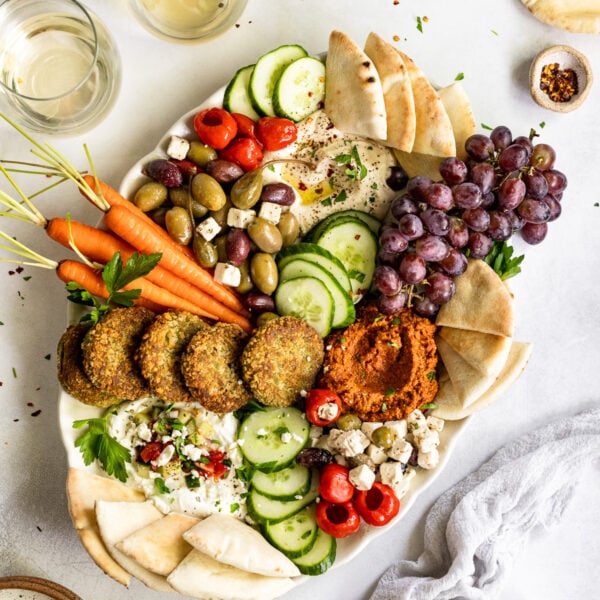




This looks amazing! And exactly what I was looking for! Thank you!
I will make it for a party next weekend and post pictures afterwards.
But I am concerned about the falafel: is it good not hot? Or do I heat it and then put it on the board? How do you handle that? Thank you1
Awesome, so glad to hear! I look forward to seeing it! Great question! We usually make it close-ish to the time of serving. So we’ll prep the board, etc, and then fry the falafel and add them last when we can. They are still good when they come to room temperature, so no worries if they’ve been sitting out a bit. However, I wouldn’t serve them straight from the fridge (cold) if you make them ahead of time. I hope that helps!